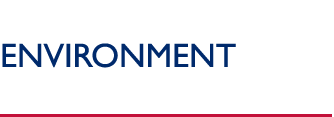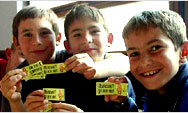 |
Safe Water Partnerships
Every year there are over 1.6 million deaths from diarrhea related to unsafe water, sanitation, and hygiene — the vast majority among children under five years of age. To address this critical public health issue, USAID is engaged in a range of partnerships to improve water quality and hygiene.
Simple household-level water treatment and safe storage interventions can lead to dramatic improvements in drinking water quality and typical reductions in diarrheal disease of 30 to 50 percent or more — making an immediate difference to the lives of those who rely on water from polluted rivers, lakes and, in some cases, unsafe wells or piped water supplies.
Products
Household-level, or point-of-use (POU), chlorination is one approach that has been tested at national scale and demonstrated to have public health impact on diarrhea as well as sufficiently low cost to allow wide coverage. USAID is currently working with two approaches to POU chlorination — the Safe Water System developed by the U.S. Centers for Disease Control and Prevention (CDC) and PuR™ developed by Procter and Gamble.
CDC’s Safe Water System was developed in response to the cholera epidemics in South America in the early 1990s, and includes three components: treatment of water at the point-of use using locally-produced sodium hypochlorite solution; safe water storage in containers with a narrow mouth to reduce the risk of water contamination; and behavior change promotion to sustain safe treatment and storage practices, as well as related behaviors, such as effective handwashing with soap.
Procter & Gamble (P&G) has developed a POU water treatment product, PuR™ Purifier of Water, which is made available to non-profit organizations at P&G’s production cost. The product is a small sachet containing a powdered flocculant (a substance that clarifies polluted water) and a time-release chlorine-based disinfectant. PuR™ is effective in treating turbid water with high levels of suspended solids, an advantage over chlorination alone, at an increase in unit cost for treatment.
Partnerships
USAID has used several partnership models to promote POU chlorination:
- Public-private partnership: As one of USAID’s Global Development Alliances, USAID has supported the The Safe Drinking Water Alliance, a public-private collaboration to develop innovative program approaches for ensuring the safety of household drinking water. USAID, Johns Hopkins Bloomberg School of Public Health/Center for Communication Programs, CARE, PSI, and Procter & Gamble joined forces to leverage their respective expertise and resources to better understand the behaviors and motivations for choosing particular technologies for treating household water, share the knowledge gained, and identify opportunities for scaling up successful efforts to ensure safe drinking water. The focus was on working with the PuR™ product with three program approaches — a commercial approach relying on P&G’s marketing and distribution channels, a “social” approach relying on marketing and distribution through not-for-profit NGOs, and distribution during emergency and humanitarian crises such as the 2006 earthquake in Pakistan. P&G determined that the commercial approach was not viable, and so most effort has focus on the social model and humanitarian assistance. Not unexpectedly, the importance of on-going intensive behavior change communications to ensure sustained adoption of POU treatment and safe storage were critical to successful efforts.
- Integration with other health activities: Point-of-use with Zinc. This recently-awarded contract with two different consortia to promote both household water treatment and the use of zinc for diarrhea treatment. The award to Abt Associates offers the opportunity to build on existing USAID-supported social marketing activities at country level, while the award to the Academy for Education Development (AED) focuses on a public-private partnership model engaging manufactures. Both awards have the capacity to work to develop commercial partnerships for product development, marketing, and distribution, useful for both POU and zinc.
- Integrate POU with a broader hygiene programs: The Hygiene Improvement Project (HIP), implemented by a consortium led by the Academy for Educational Development (AED) builds on USAID’s thirty years of investments in water, sanitation and hygiene. HIP provides a strong focus on improvements at large scale in three key hygiene practices: safe feces disposal, proper hand-washing with soap, and point-of-use water treatment and safe storage. Each of these interventions typically results in a 30 to 40 percent reduction in diarrheal prevalence in children under five. HIP’s approach is to strengthen partnerships, coordinate efforts between the various actors involved in health and hygiene, and to engage the private and commercial sectors to ensure availability of products and services.
- Support Networks: The International Network to Promote Household Water Treatment and Safe Storage. USAID is an active member of this network since it was formed in 2003, with the Secretariat housed at the World Health Organization in Geneva. The mission of the Network is to contribute to a significant reduction in waterborne disease, especially among vulnerable populations, by promoting household water treatment and safe storage as a key component of water, sanitation and hygiene programs. Members include government offices or Ministries working in health and water quality, local governments considering household-level pilot projects, NGOs carrying out projects in communities or training implementers, universities, companies developing products, and other stakeholders.
- Technical assistance partnerships: USAID works closely with the Centers for Disease Control and Prevention (CDC)’s to provide technical assistance through CDC on Safe Water System and related activities.
Back to Top ^
|


